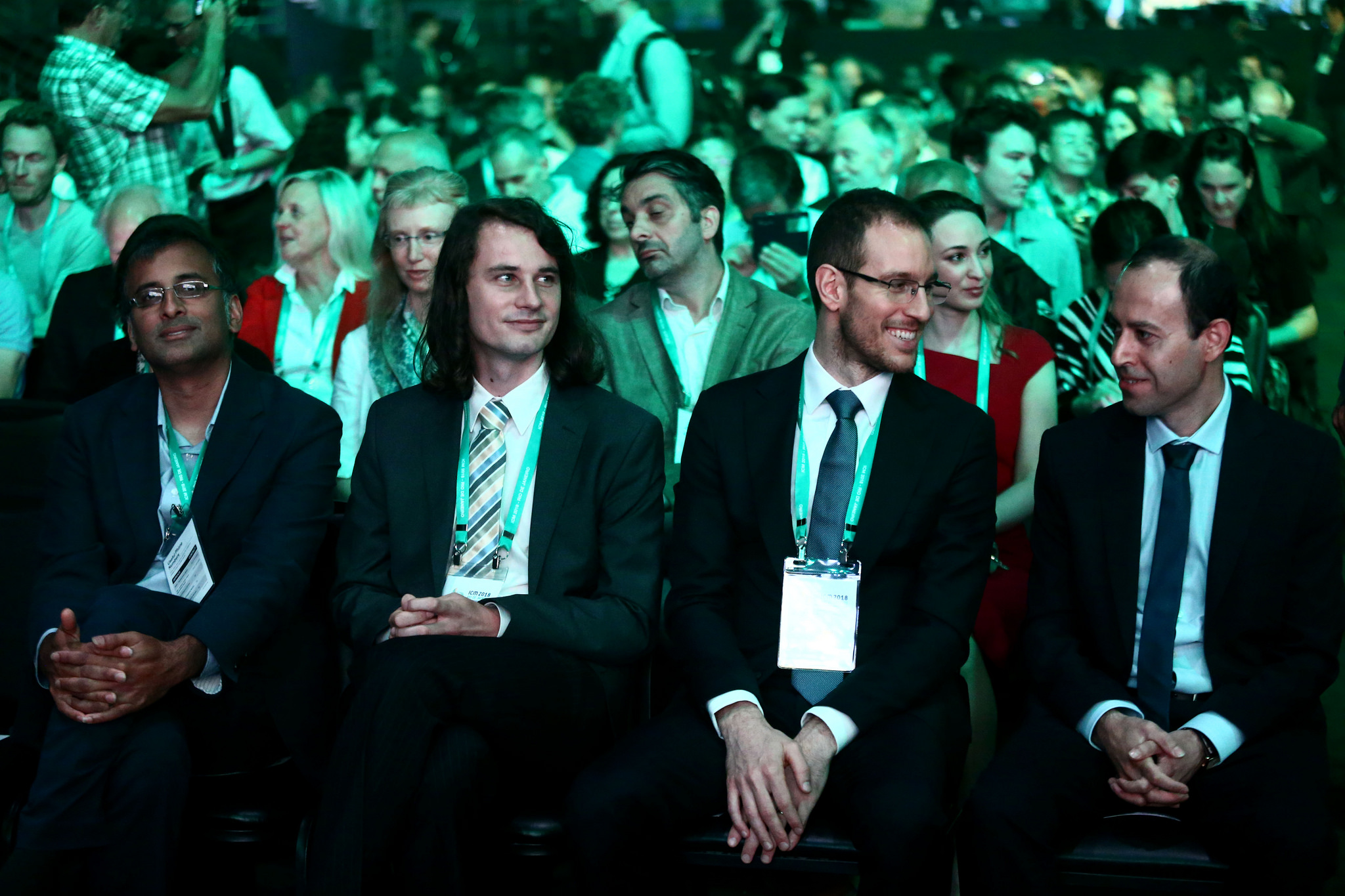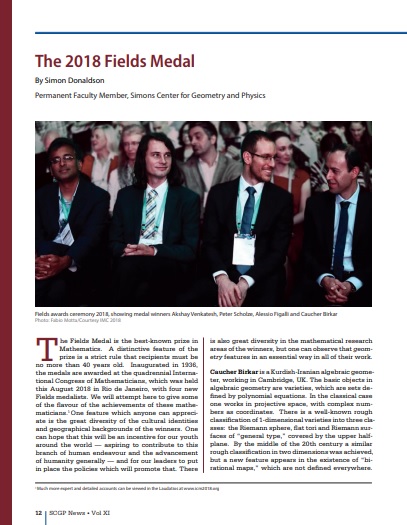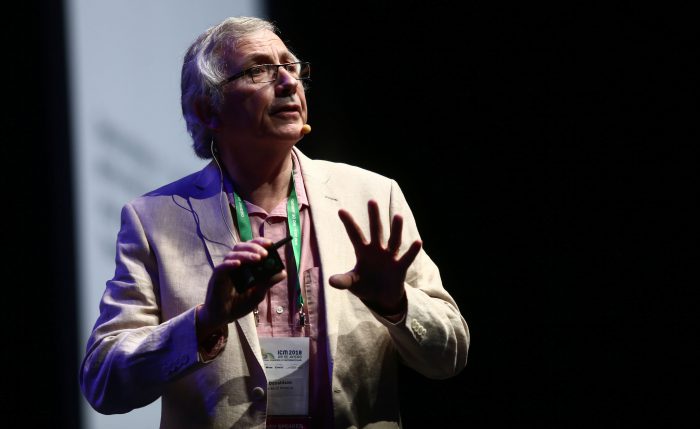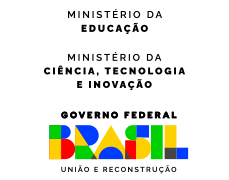The 2018 Fields Medal, by Simon Donaldson

Fields awards ceremony 2018, showing medal winners Akshay Venkatesh, Peter Scholze, Alessio Figalli and Caucher Birkar Photo: Pablo Costa/Courtesy ICM 2018
Source: Simons Center for Geometry and Physics News
By Simon Donaldson
Permanent Faculty Member, Simons Center for Geometry and Physics
The Fields Medal is the best-known prize in Mathematics. A distinctive feature of the prize is a strict rule that recipients must be no more than 40 years old. Inaugurated in 1936, the medals are awarded at the quadrennial International Congress of Mathematicians, which was held this August 2018 in Rio de Janeiro, with four new Fields medalists. We will attempt here to give some of the flavour of the achievements of these mathematicians.1One feature which anyone can appreciate is the great diversity of the cultural identities and geographical backgrounds of the winners. One can hope that this will be an incentive for our youth around the world — aspiring to contribute to this branch of human endeavour and the advancement of humanity generally — and for our leaders to put in place the policies which will promote that. There is also great diversity in the mathematical research areas of the winners, but one can observe that geometry features in an essential way in all of their work.
Read more: Faculty position in Applied Mathematics
Fields Medal and Abel Prize winner, Michael Atiyah dies at 89
Donaldson outline advances in Differential Geometry
Caucher Birkar is a Kurdish-Iranian algebraic geometer, working in Cambridge, UK. The basic objects in algebraic geometry are varieties, which are sets defined by polynomial equations. In the classical case one works in projective space, with complex numbers as coordinates. There is a well-known rough classification of 1-dimensional varieties into three classes: the Riemann sphere, flat tori and Riemann surfaces of “general type,” covered by the upper halfplane. By the middle of the 20th century a similar rough classification in two dimensions was achieved, but a new feature appears in the existence of “birational maps,” which are not defined everywhere.
A major line in algebraic geometry over the past 40 years has been the extension of these classification results to higher dimensions, in what is called the minimal model programme. A breakthrough came in 2006 in work of Birkar, Cascini, Hacon and McKernan, which achieved some of the main goals of this programme. In particular they established that on a variety of general type the sections of the powers of the canonical bundle form a finitely generated ring, which leads to a preferred representative in the birational equivalence class. More recently, Birkar has obtained other fundamental results — extending the theory to fields of finite characteristic and establishing bounds on the class of Fano varieties (which are higher dimensional analogues of the Riemann sphere).

Alessio Figalli is an Italian mathematician, working in Zurich. He works on the analysis of partial differential equations, with connections to physical applications and to geometry. Some of his best-known work involves equations of Monge-Ampère type and optimal transport. Suppose one has two density functions ρ1, ρ2 supported in domains Ω1, Ω2 in Rn. The problem of optimal transport is to find the most efficient way of transporting material from Ω1, with density ρ1, to Ω2, with density ρ2. If the cost of transport is quadratic in distance the solution is given by a map which is the derivative of a function u on Ω1, and the density condition becomes an equation for det ( ∂2u/ ∂xi∂xk ).
Figalli obtained refined results on the regularity of solutions to such Monge-Ampère equations (which arise in many other contexts). He, and coauthors, also used optimal transport to obtain geometric results about sets in Rn, such as generalised isoperimetric inequalities. Figalli has made important contributions to other partial differential equations, including the structure of singularities in freeboundary problems.
Peter Scholze is a German mathematician, working in Bonn. His work is in the area of arithmetic algebraic geometry, which studies connections to number theory. One of his main achievements is the development of a far-reaching theory of p-adic spaces. Recall that the real numbers can be obtained by “completing” the rationals. If p is a fixed prime, the p-adic numbers Qp are another completion, starting from the idea that a rational is deemed to be small if its numerator is divisible by a high power of p.
Scholze defined “perfectoid spaces,” based on adjoining infinitely many roots of p to the p-adic numbers, for which he could introduce a “tilting” to pass between characteristic p and characteristic 0. Among many other results in his theory, he established padic analogues of the classical Hodge theory, relating different cohomology groups. All of these results have important consequences for sophisticated “reciprocity laws”in number theory and in connection with the Langlands programme.
Ashkay Venkatesh is an Australian mathematician, born in India and working in Stanford. His work is many-faceted but also involves the interaction between geometry, topology, analysis and number theory. Many of his results involve an arithmetic group Γ acting on a symmetric space, for example Γ could be SL(2, Z) acting by Möbius maps on the upper half plane X, in which case X/Γ is the moduli space of complex tori (elliptic curves). Venkatesh proved equidistribution and ergodic theorems for the images of certain subgroup orbits in X/Γ and used these to establish “subconvexity” bounds on the growth of L-functions associated to modular forms on X. These bounds have important consequences for the solutions of systems of quadratic equations in integers (the 11th in the famous list of problems stated by Hilbert in 1900). In recent work, Venkatesh and collaborators discovered new structure on the topological cohomology of spaces X/Γ, again related to reciprocity laws in number theory and to the Langlands programme. In a different direction, Venkatesh and collaborators proved results in topology (on the stabilisation of the homology of Hurwitz spaces, which classify branched covers of the Riemann sphere) and applied these to arithmetic, in the form of asymptotic results about function fields in finite characteristic. A recipient of a Fields Medal in 1986 and a Shaw Prize medal in 2009, Simon Donaldson’s recent awards include the degree “Docteur Honoris Causa” by Université Joseph Fourier, Grenoble in 2014. Later that year, he was awarded the Breakthrough Prize in Mathematics for revolutionary invariants of 4-dimensional manifolds and for the study of the relation between stability in algebraic geometry and differential geometry. In 2017, Donaldson was awarded the degree “Docteur Honoris Causa” by the Universidad Complutense de Madrid, Spain.

Simon Donaldson at his ICM 2018 plenary lecture in August in Rio. Photo: Pablo Costa/ICM 2018
A recipient of a Fields Medal in 1986 and a Shaw Prize medal in 2009, Simon Donaldson’s recent awards include the degree “Docteur Honoris Causa” by Université Joseph Fourier, Grenoble in 2014. Later that year, he was awarded the Breakthrough Prize in Mathematics for revolutionary invariants of 4-dimensional manifolds and for the study of the relation between stability in algebraic geometry and differential geometry. In 2017, Donaldson was awarded the degree “Docteur Honoris Causa” by the Universidad Complutense de Madrid, Spain.
Read more: ‘When students are excited about math, they perform best’
Cédric Villani delivers public lecture on ‘age of the earth’
Collaboration is key for mathematicians Robert Morris and József Balogh


